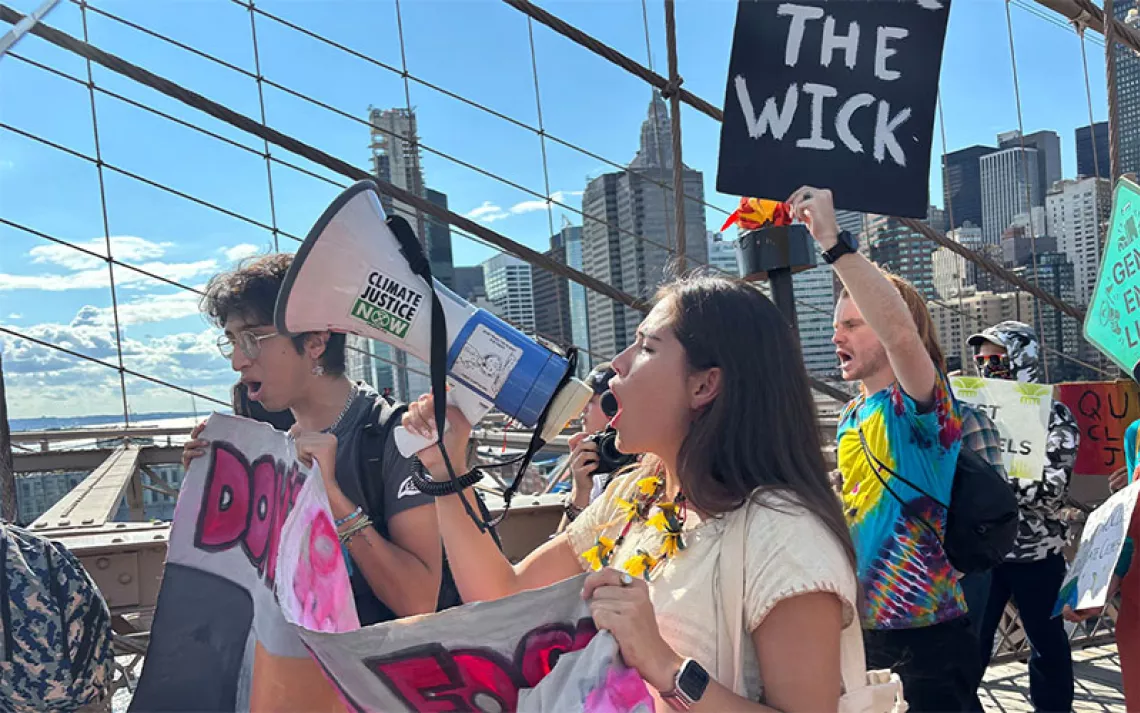Frontline Communities Will Be Front and Center at Peoples Climate March
On April 29, a broad climate coalition will unite in D.C. and across the nation

The first Peoples Climate March, September 21, 2014| Photo courtesy of the Sierra Club
When Jason Robinson moved into an apartment in the Little River neighborhood of Miami four years ago, no one told him about sunny-day flooding. Seawater filled the streets, and it got worse over time: rising in the morning, then receding before coming back midday, and returning again at around 3:00 A.M. “Whenever the water would come up, if your car was parked in a bad spot or depending on how high the water rose, it would damage the cars on the street,” he says. “Once, the water rose so high it came into my car, ruined the computer I had inside, and damaged the brakes.”
On a regular basis, Robinson says, seawater flooded the landscaping around the neighborhood to the extent that it killed the grass and led to sea moss and sea algae growing on the concrete. A truck driver by trade, Robinson recently moved out of the neighborhood. The tidal flooding played a big factor in his decision, he says.
Rising sea level is just one of the many ways that climate change is already affecting low-lying neighborhoods like Little River, which often receive little financial support from local governments or federal agencies to deal with the problem, let alone public education about why it’s happening and how to adapt. In the mixed-income neighborhood of Shorecrest in Miami, sunny-day flooding has made life miserable for residents. Not far away, however, in the affluent community of Miami Beach, work is well underway around sea-level-rise adaptation such as raising roads, putting in barriers, and organizing public education. That inequity in climate response is why local nonprofit organizations such as Catalyst Miami and the New Florida Majority are working hard to raise up the voices of those most vulnerable to climate impacts—the frontline communities for which climate change is a reality right now.

Street flooding at 7 P.M. in the Little River neighborhood of Miami, Florida | Photo courtesy of Jason Robinson
Those communities will be front and center on Saturday, April 29, when a broad coalition of labor, faith, youth, immigrant, LGBTQ, civil rights, environmental, and social justice organizations unite for the Peoples Climate March, taking to the streets in the nation’s capital and cities across the country.
This is the second Peoples Climate March. The first took place on September 21, 2014, with a historic mobilization in New York City to respond to the growing climate threat. On the eve of the UN Climate Summit, nearly half a million people converged in Manhattan to demand that world leaders act to avoid a planetary catastrophe should human-caused global warming be allowed to continue unmitigated.
This year’s march falls on the 100th day since the Trump administration took power. Last fall, as efforts got underway to plan for a second Peoples Climate March, organizers selected April 29, 2017, as the date well before the outcome of the presidential election was known. They wanted to make sure that the new administration, regardless of who won, made climate and the transition to a clean-energy economy a priority. “We want the Peoples Climate March to put into action a message to the world of how we can, and must, come together to respond to this crisis: that we resist, we build, we rise, and ultimately, that we will win,” Rev. Lennox Yearwood Jr., president and CEO of the Hip Hop Caucus and one of the march coalition partners, said in an interview. “I want us as a climate movement to do everything we have to do to win on the issues and the policies regarding climate change, and to begin to change the trajectory of how we involve people in the actual movement.”
Rev. Yearwood is a pioneer in using art, music, and culture as a means through which to mobilize grassroots movements for climate justice. He will be marching in D.C. on April 29, and the Hip Hop Caucus is working to turn out students and youth groups for the event as well as artists and climate activists such as Antonique Smith. “We have to catapult this march and take it out to communities like Flint and Standing Rock, but also to Spartanburg, South Carolina, or Detroit and Memphis, or Oakland, California, and Richmond, Virginia,” Rev. Yearwood said. “Part of our job as a movement is to educate and broaden the movement for these vulnerable communities.”
Paul Getsos was the national coordinator for the first Peoples Climate March and continues in that capacity today. The coauthor of Tools for Radical Democracy, he has been a civic organizer for over 30 years. “We’ve been working since 2014 to build a broader coalition and engage organizations with a particular focus on labor unions, communities of color, and immigrants' rights groups,” Getsos says. “We’ve also been figuring out how to align around a common agenda, particularly around transitioning to a new just clean energy and renewable energy future, which is why we have labor unions and others around the table. Climate change is not just an environmental issue; it’s a basic people’s issue.”
The original plan for the march was to stage it in Washington, D.C., only. But overwhelming grassroots interest has expanded the day of resistance to include over 220 sister marches in cities across the country. According to Getsos, that happened organically from local community and advocacy groups stepping forward to participate as word about a new climate march spread.
Many of those communities have been reeling since the Trump administration took power and rolled out two Muslim travel bans, a failed attempt to torpedo national health care, and proposals to slash federal funding for everything from the EPA and Planned Parenthood to Pell Grants. The administration’s policies presented a particular challenge to the march organizers: How do you connect their issues, and their struggles—against injustice, racism, sexism, homophobia, and inequity—to the climate struggle?
“Our labor union folks are under attack around worker’s rights and the right to unionize; immigrant-rights groups are addressing ICE raids; communities of color and low-income folks are addressing cuts to HUD and urban housing programs,” Getsos says. “Climate change can be very different for some folks than having your housing cut, or losing your health care, or having your family members deported. At the same time, increasingly whenever I talk to a group of people, everyone understands that climate change is very important. So figuring out how to activate those people while they are also concerned about their other issues is the challenge, and the thing we’re trying to do.”
Maura Cowley is the director of the Sierra Club's International Climate and Energy campaign and coordinates the Club’s organizing and coalition-building work with the Peoples Climate Movement. “Frontline communities are leading the climate movement and have been for a long time,” she said. “Community organizations all across the country, from Appalachia to Los Angeles to Miami and New York City, are out there day in and day out to make sure that big polluters aren’t moving into their communities, that the fossil fuel industry is regulated, and to push for clean energy locally.”
Organizers are planning events around the country with local artists and community leaders as well as youth groups, immigrant rights groups, labor leaders, and community-of-color organizations to talk about renewable energy, energy efficiency, just transition, and investment in new strategies and ways to address the climate crisis. The week before the march takes place, coalition leaders will go to Capitol Hill to meet with members of Congress and ask them to take the pledge for clean air, clean water, clean energy, and good jobs, as well as to demand a stop to the Trump administration’s proposed cuts to the EPA and the Clean Power Plan rules.
Nicole Hernandez Hammer is a sea-level researcher and Spanish speaker who will join a contingent of scientists marching on April 29. She focuses on climate impacts on a variety of different natural and urban systems, and is a climate science and community advocate at the Union of Concerned Scientists. Her research into impacted communities in Florida such as Shorecrest spurred the involvement of partners including Catalyst Miami and the city of Miami to take action, and she initiates contact with residents like Jason Robinson so that their stories can be heard. At Michelle Obama’s invitation, Hernandez Hammer sat next to the first lady as President Obama delivered the State of the Union address in 2015. “We have known for a long time that there is a disproportionate impact of pollution on communities of color,” Hernandez Hammer says. “We are finding that the same can be said for climate change impacts.”
In researching what communities are the most vulnerable to sea-level rise, she noticed they also tend to be the places with the fastest growing Latino populations. Hernandez Hammer investigated what kind of outreach is being done about sea level and vulnerable communities. The answer was discouraging: not much. “I felt I was in a unique position as a scientist, and as a Latina, to move that kind of work forward,” she said.
She continues to work with the Union of Concerned Scientists to identify low-lying, low-income communities in Florida where during the high tides of the year, there is now flooding. She has since worked with those communities in partnership with local university and local community groups to bring attention to what is happening there, and educates residents about what they can do.
“There are climate change impacts that we’re going to be able to avoid if we take quick action, but there are also impacts of climate change that are baked in, that we weren’t going to be able to avoid,” Hernandez Hammer says. “So we need to make sure that as we begin to adapt to this new reality, we support frontline communities and communities of color, and that there’s equity in that work. Climate adaptation isn’t a copy-paste exercise. It has to be tailored to the needs of each community.”
Hernandez Hammer says that the science community has been in a state of shock over the Trump administration’s anti-science agenda, which is why she’s marching on the 29th with other scientists. “We realize that, when we’re in a situation like this, it just means we have to work harder, and keep pushing forward even more so, because we know there is little time left to prevent the worst impacts, and very little time to adapt to the things we know are coming that we can’t avoid.”
The event comes on the heels of one of the most significant protests in recent years in the form of the Women's March on Washington, D.C., and cities nationwide.
“We have to do a lot more to revitalize our movement at this time,” Rev. Yearwood says. “We have to figure out a way in which we continue to reinforce the many layers of this movement. We can’t win with a siloed climate movement. We can’t have a movement where you have folks dealing with fracking or mountaintop removal or Keystone or DAPL separate from each other. We have to figure out how to fight these battles together.”
 The Magazine of The Sierra Club
The Magazine of The Sierra Club



